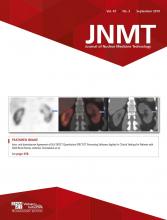Kathy S. Thomas, MHA, CNMT, PET, FSNMMI-TS
In the June issue of JNMT, I reviewed the basic results of the recent JNMT survey. To summarize, readers appreciate the number of continuing education (CE) articles in each issue and feel that the newly added features—Practical Protocol Tips and the Educators’ Forum—are of value and the teaching cases and scientific research manuscripts continue to support professional growth. Additionally, there was a “thumbs-up” for another proposed feature, Practical Pointers, which will provide a concise answer to a question associated with a single topic, “What Is It?” and “Why Is It Important.” Based on that response, the September issue will launch with the first Practical Pointer titled, “Thyroid Uptake Exceeding 100%: How Is That Possible?” (1).
These basic findings were important to confirm, but the comments and suggestions provided me with more focused information as readers described in their own words what was important, what was needed to enhance professional growth, and where JNMT could be improved.
The problems associated with CE exams have been addressed. Wrong answers are now noted to allow individuals to know areas that require further study. JNM CE articles now have two exams, one for the physician/scientist and one for the technologist. The technologist exam assesses only content included in the article and does not rely on knowledge outside the manuscript (e.g., cited references). The timeliness of exam availability following publication of JNMT is also being addressed and should be resolved. That area will be monitored closely.
For topics, I wasn’t surprised to note the wide variety of suggestions that were clearly dependent on work environment. For those working in small or rural settings, the request for more clinically relevant, back-to-basic topics that can be implemented outside a university or large teaching hospital setting came through loud and clear. Readers from these areas appreciate reading about state-of-the-art procedures and radiopharmaceuticals; however, in small community hospitals, clinics, and rural settings, application of that information is out of reach. Readers from large teaching hospitals and university settings look to the JNMT for the latest in clinical research and product development to apply to diagnostic and therapeutic procedures. Requested topics include protocols and procedures in PET/CT, PET/MR, SPECT/CT, clinical research, and anything related to theranostics.
Topics seldom found in JNMT were also highlighted, including cardiology, pediatrics, and professional development. Professional development was further broken down to include management issues, patient handling tips, implementation of efficiency in practice (e.g., 6-Sigma) to improve technologist and patient flow, and billing/reimbursement. Although we have had some success in finding authors to share professional development tips, there is definitely room for improvement to include more information in all of the areas noted. With the help of volunteer authors and my associate and consulting editors, I hope to improve in all of these areas and provide both back-to-basic and advanced technical information in the future.
One final question was asked, “Have you or would you consider writing an article for JNMT?” Although most responders answered, “No, too busy,” some individuals noted that with the help of a mentor, they would consider sharing their expertise by writing an article for JNMT. Only one individual actually provided contact e-mail information, but for those who answered “Yes,” please contact me! We have mentors available to help you get published!
In the current JNMT issue, we are once again fortunate to offer a variety of CE topics. Geoffrey Currie (2) completes his series on pharmacology with a comprehensive discussion on CT and MRI contrast. Sara L. Johnson’s (3) CE article on professional development shares the concept of authentic leadership and the development of a new generation of effective and authentic leaders to face the challenges in our field. In the third CE article, Jessica Williams and Ellie Mantel (4) provide an overview of newer, less frequently used diagnostic agents and related therapeutic radiopharmaceuticals. Finally, Harvey Ziessman (5) discusses pharmacologic intervention in cholescintigraphy and the recommended infusion method of sincalide.
Additional topics of interest in this issue include the introduction of a relatively new subject, artificial intelligence, and its application in nuclear medicine; a functional manikin used in the classroom called JUNO that can be programmed to simulate common patient ailments and complaints; and a variety of physics/instrumentation discussions on image reconstruction, quantitative processing, and analysis.
At the Society of Nuclear Medicine and Molecular Imaging Annual Meeting in June, two courses were offered to provide future authors and reviewers with the tools to be successful. The quality and content of the JNMT relies on two important factors: a continuous stream of manuscripts and the review of those manuscripts by volunteer nuclear medicine professionals. Every nuclear medicine professional is an expert in some aspect of nuclear medicine. I would like to encourage each of you to consider sharing that expertise by becoming an author for JNMT—and don’t panic! We have mentors to help you be successful! And don’t forget, aside from the prestige and bragging rights of being published, there may be financial benefits associated with being published! For those not yet ready to put pen to paper—ok, so I’m “old school,” how about “fingers to the keyboard”—consider becoming a reviewer. We have educational programs to help you be successful in either area. If you are interested in becoming an author or reviewer, please contact me at ksthomas0412{at}msn.com.
As always, I value your comments and suggestions and especially appreciate the input received from the JNMT survey. With your help and support, the JNMT will continue to provide informational content to support your professional growth.








